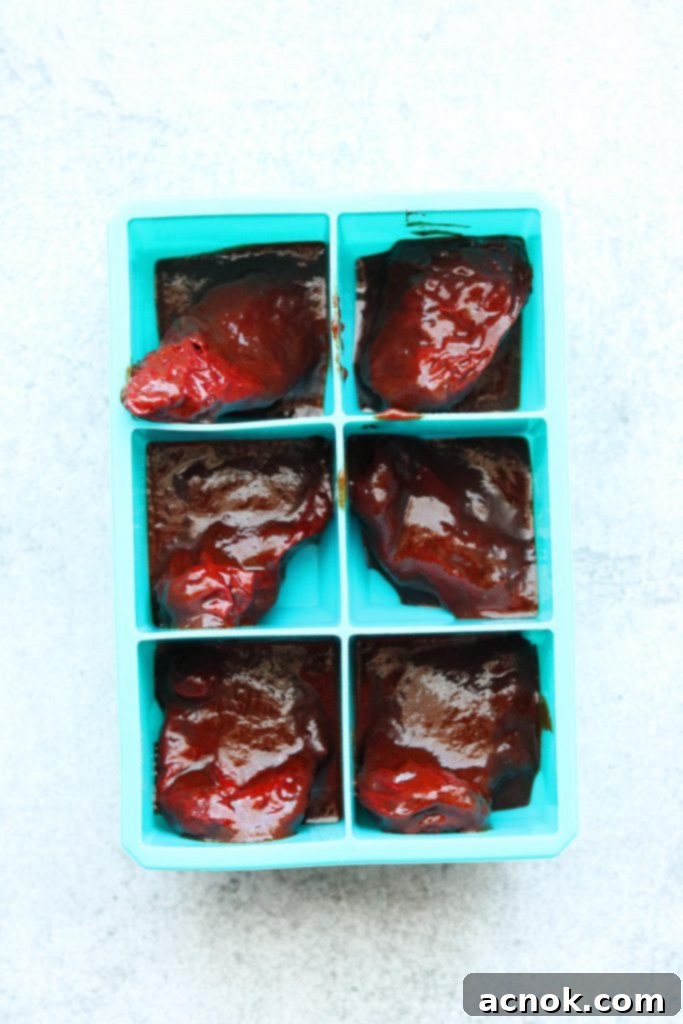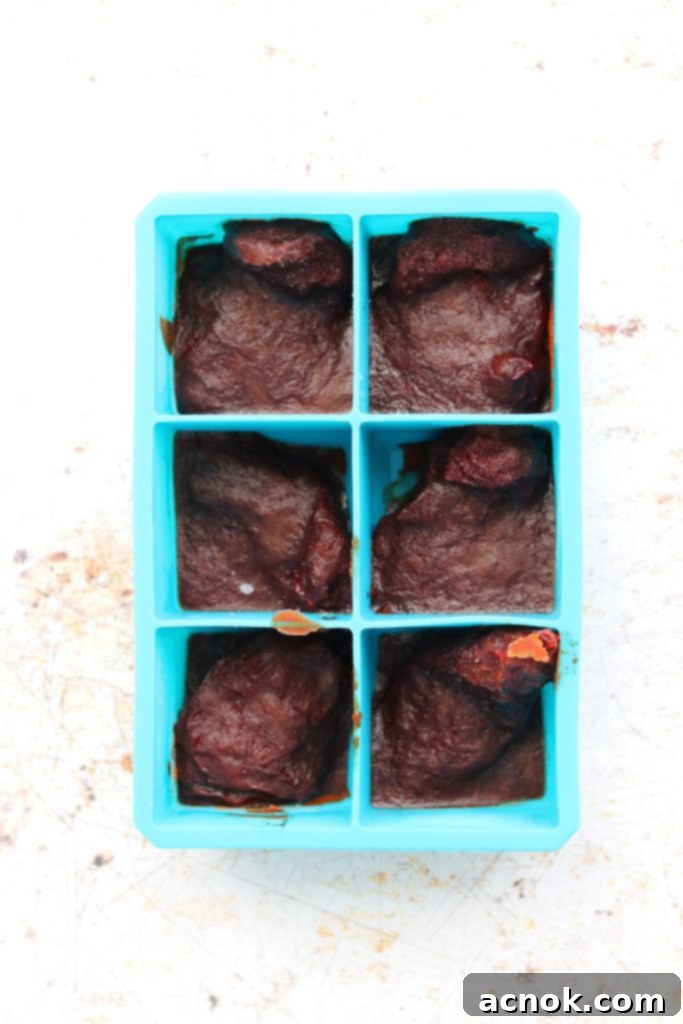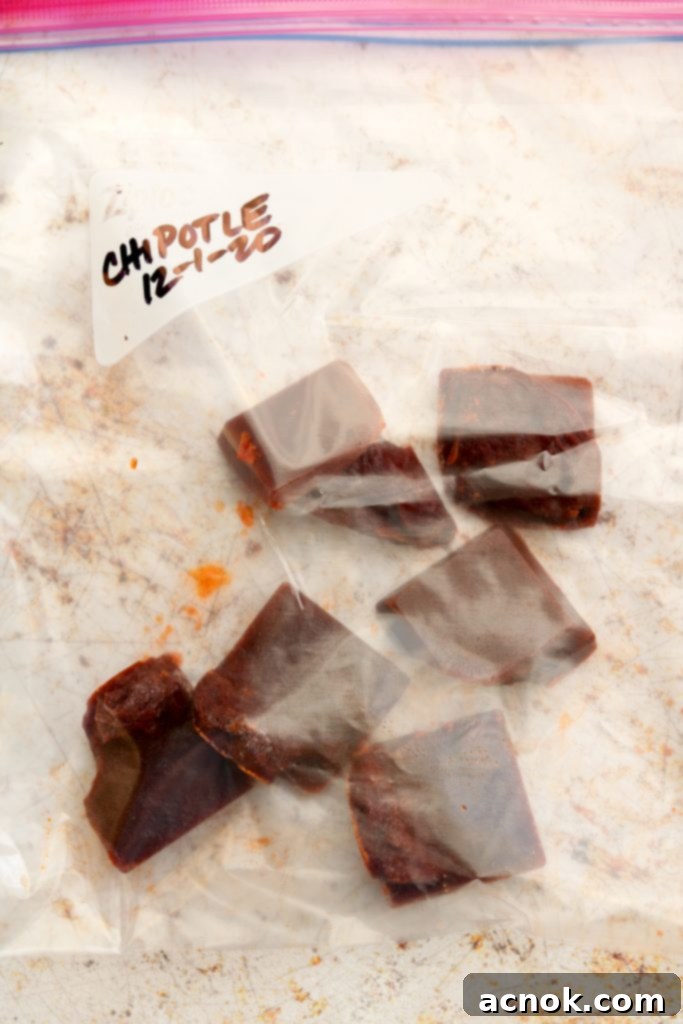Mastering Food Preservation: How to Freeze Chipotle Chiles (and Other Ingredients) for Ultimate Kitchen Convenience
In the bustling world of home cooking, efficiency and the thoughtful management of ingredients are paramount. Few things are as frustrating as opening a can of a specialized ingredient, using only a small portion, and then watching the remainder go to waste in the back of the refrigerator. This common scenario often leads to unnecessary food waste, a lighter wallet, and missed opportunities for flavor. But what if there was a simple, yet incredibly effective, solution that not only preserves these precious ingredients but also streamlines your cooking process, making it more economical and enjoyable? The answer lies in a clever kitchen hack: freezing your leftover ingredients in perfectly portioned cubes.
Recently, while crafting my vibrant Roasted Brussels Sprouts with Red Chimichurri, I encountered a familiar dilemma. The recipe called for a single canned chipotle chile in adobo sauce, leaving a substantial amount of the smoky, spicy goodness unused. Instead of allowing the remaining chiles to sit and spoil, I turned to a tried-and-true method that has become an indispensable part of my kitchen routine: freezing the excess in a silicone ice cube tray. This ingenious technique isn’t limited to just chipotles; it’s a versatile strategy I frequently employ for a wide array of ingredients, from various tomato products to fresh herbs, rich broths, and much more, transforming how I manage my pantry and prepare meals.
The Undeniable Advantages of Silicone Ice Cube Trays for Food Preservation
The cornerstone of this highly effective food preservation method is the humble silicone ice cube tray. Unlike rigid plastic trays that can make releasing frozen items a frustrating battle, silicone’s inherent flexibility allows for effortless removal of individual portions. The trays I personally prefer and use are designed for large ice cubes, making them exceptionally well-suited for freezing cooking ingredients. Each compartment typically holds about 1/2 cup of liquid or solid ingredients. This capacity provides perfectly sized, ready-to-use portions that are ideal for most recipes, eliminating the need for guesswork, awkward defrosting of large blocks, and, crucially, significantly reducing food waste.
As an Amazon Associate I earn from qualifying purchases.
A Detailed Guide: Freezing Chipotle Chiles for Future Culinary Adventures
Let’s delve into the specific process for preserving those wonderfully smoky and spicy chipotle chiles. When you open a can of chipotles in adobo, you’ll find the chiles immersed in a rich, flavorful sauce. Both the chiles themselves and the adobo sauce are packed with intense flavor and are far too valuable to discard. Here’s how to save them efficiently and effectively:
- Careful Portioning: Begin by carefully spooning one whole chipotle chile—or several chopped pieces, depending on your usual recipe needs—into each compartment of your silicone ice cube tray. It’s crucial to also spoon in a generous amount of the accompanying adobo sauce alongside each chile. This sauce is pure liquid gold, brimming with depth and complexity, and it will infuse your future dishes with incredible flavor.
- Cover and Freeze Thoroughly: Once all compartments are filled, cover the tray securely. You can use aluminum foil, plastic wrap, or a lid if your tray comes with one. This vital step helps prevent freezer burn, which can degrade the quality and flavor of your ingredients, and also protects against unwanted absorption of freezer odors. Place the covered tray in the freezer and allow it to freeze solid, which typically takes several hours or, ideally, overnight.
- Transfer for Long-Term Storage: Once the contents are completely frozen and firm, remove the tray from the freezer. Thanks to the flexibility of silicone, you can easily pop out each perfectly formed, individual chile cube. Transfer these convenient portions into a freezer-safe ziplock bag or an airtight container. An essential final step is to clearly label the bag or container with the contents (e.g., “Chipotle Chiles in Adobo”) and the date of freezing. This simple practice will save you time and confusion later on.
- Effortless Integration into Cooking: With your stash of pre-portioned chipotle chiles now organized, you have a potent flavor enhancer ready whenever culinary inspiration strikes. Whether you’re simmering a hearty batch of chili, whipping up a smoky marinade for meats, preparing a vibrant sauce for tacos, or blending a spicy dip, simply grab a cube or two and add it directly to your dish. In most applications, there’s no need for advance thawing; the heat of your pan or pot will quickly melt and integrate the frozen cube, releasing its full, robust flavor.



Beyond Chipotle: A World of Ingredients Perfect for Tray Freezing
While chipotle chiles are an outstanding candidate for this freezing method, the possibilities for what you can preserve truly expand far beyond a single ingredient. This kitchen hack is a fantastic way to manage a multitude of common and specialized ingredients, ensuring nothing goes to waste and you always have a secret flavor weapon ready for your next culinary endeavor. Explore some of the most popular and effective uses:
Tomato Products – The Kings of Convenient Freezing
- Tomato Paste: This is arguably one of the most common leftover ingredients. Few recipes demand an entire tube or can of tomato paste. Instead of letting the remainder dry out, spoon it into smaller ice cube tray sections. Once frozen, transfer these concentrated flavor bombs to a freezer bag. They are perfect for enriching sauces, deepening the flavor of soups, and thickening stews.
- Crushed or Diced Tomatoes: If you’ve opened a large can for a recipe that only calls for a small amount, don’t despair. Freeze the rest in larger compartments. These robust cubes are excellent additions to chilis, pasta sauces, or for making a quick, rustic shakshuka.
- Tomato Sauce: Leftover marinara, plain tomato sauce, or even tomato purée can be frozen in cubes for quick additions to weeknight meals, acting as a versatile base for countless dishes.
Herbs and Aromatics – Freshness on Demand
- Fresh Herbs (in Oil or Water): Delicate herbs like parsley, cilantro, basil, or stronger, woody varieties like rosemary and thyme are often sold in larger bunches than needed. Chop them finely, place them into ice cube trays, and cover with a neutral oil (like olive oil) or water. Once frozen, these cubes can be dropped directly into sautéing vegetables, soups, or sauces, releasing their vibrant, fresh flavor without the need for fresh chopping.
- Ginger or Garlic Paste: If you enjoy buying bulk ginger or garlic, prepare a paste by puréeing it with a little oil. Freeze this paste in small cubes for instant aroma and flavor whenever your recipe demands it, saving you time from peeling and grating.
Broths, Stocks, and Sauces – Flavor Boosts at Your Fingertips
- Chicken, Beef, or Vegetable Broth: Often, you need just a splash of broth to deglaze a pan, add moisture to a stir-fry, or enrich a risotto. Freezing broth in 1/2-cup or even smaller portions is incredibly convenient for these quick flavor boosts.
- Pesto: A whole jar of pesto can be too much for a single meal. Freeze individual dollops in trays. These are perfect for quick pasta dishes, spreading on sandwiches, stirring into soups, or adding to scrambled eggs for an unexpected twist.
- Wine: Leftover wine from a bottle is ideal for freezing in cubes. These cubes are perfect for cooking, adding a sophisticated depth of flavor to sauces, gravies, and braises without the need to open a fresh bottle.
Other Creative and Useful Applications
- Lemon or Lime Juice: Freshly squeezed citrus juice can be frozen in small cubes. They are perfect for cocktails, homemade dressings, or for adding a bright, zesty note to any dish.
- Coffee: Freeze leftover brewed coffee into cubes. Use these in iced coffee to prevent dilution and maintain a strong, rich flavor.
- Pureed Fruits and Vegetables: Excellent for portioning baby food, or for having ready-to-use additions for smoothies and healthy drinks.
The Unbeatable Benefits of Embracing Portion-Freezing in Your Kitchen
Adopting this simple yet powerful freezing technique brings a multitude of advantages that will transform your kitchen habits and enhance your lifestyle:
- Significant Reduction in Food Waste: This is arguably the most impactful benefit. By actively preserving unused ingredients, you dramatically cut down on the amount of food that ends up in the trash, which is beneficial for both your household budget and the environment.
- Substantial Cost Savings: Every piece of food you throw away represents money wasted. By intelligently freezing and reusing excess ingredients, you ensure you get the maximum value out of every grocery purchase.
- Unmatched Convenience: Imagine having perfectly measured portions of your most frequently used ingredients readily available at a moment’s notice. This significantly reduces prep time, making weeknight cooking much less stressful and more enjoyable. No more last-minute chopping or measuring from large, unwieldy containers.
- Consistent Flavor and Quality: Freezing is an excellent method for locking in the freshness and flavor of ingredients. When you retrieve and use them later, they maintain their quality, tasting just as vibrant as when they were first prepared or opened.
- Streamlined Meal Preparation: For those who actively engage in meal prepping, this method is a true game-changer. Prepare batches of sauces, purées, or chopped aromatics, freeze them, and then simply add them to your daily cooking as needed, simplifying complex recipes.
- Precise Portion Control: Whether you’re adhering to a specific recipe, managing dietary intake, or simply want consistent results, having pre-portioned ingredients helps maintain accuracy and consistency in your cooking.
Selecting the Right Tools and Implementing Best Practices for Optimal Freezing
To fully harness the advantages of this portion-freezing strategy, it’s wise to invest in the appropriate tools and diligently follow a few straightforward best practices:
Essential Kitchen Tools:
- High-Quality Silicone Ice Cube Trays: Seek out trays made from food-grade silicone that are both durable and easy to clean. As previously mentioned, trays with larger compartments (e.g., 1/2 cup per cube) offer exceptional versatility for a wide range of cooking ingredients.
- Freezer-Safe Bags or Airtight Containers: Once your cubes are frozen solid, transferring them to these specialized containers is crucial. They protect your ingredients from freezer burn, which can degrade quality, and help you save valuable space in your freezer.
- Labels and Markers: This step is absolutely critical! Always label your bags or containers clearly with the contents (e.g., “Pesto Cubes”) and the date they were frozen. This prevents future confusion and helps you keep track of the ingredients’ shelf life.
Key Best Practices for Optimal Freezing:
- Minimize Air Exposure: Air is the primary culprit behind freezer burn. Ensure your trays are adequately covered while freezing. Once transferred to bags, squeeze out as much air as possible before sealing to create a vacuum effect, further protecting your ingredients.
- Label Everything Diligently: This simple act saves immense headaches later. Even if you think you’ll remember what’s in an unlabeled bag, experience shows that memory often fails in the face of a freezer full of mysterious packages.
- Freeze Quickly: The faster food freezes, the smaller the ice crystals that form within it. Smaller ice crystals help to better preserve the texture and quality of the ingredients once thawed.
- Thawing Smartly: Many frozen cubes, like chipotles or tomato paste, can be added directly to hot dishes, where they will melt and integrate. For larger items or ingredients where texture is paramount, it’s best to thaw them slowly in the refrigerator overnight.
- Understand Shelf Life: While freezing significantly extends the life of food, it does not make it indefinite. Most frozen ingredients will maintain their optimal quality for 3-6 months. Always refer to general freezer guidelines for specific ingredient types for more precise recommendations.
The specific silicone trays I utilize and enthusiastically recommend for their robustness and user-friendly design are conveniently linked below:
Join the Conversation: How Do You Master Leftover Preservation?
This simple yet profound kitchen hack has truly revolutionized the way I approach cooking, meal planning, and combating food waste in my home. It stands as a testament to how even minor adjustments in our kitchen routines can lead to significant improvements in efficiency, economy, and the overall enjoyment of cooking. We’ve explored the invaluable technique of freezing chipotle chiles, various tomato products, fresh herbs, and more, all with the overarching goal of making your kitchen a more organized, efficient, and flavorful space.
We are always eager to discover new tips, tricks, and ingenious methods from our vibrant community of home cooks. How do you creatively preserve your leftovers and excess ingredients? Do you have a unique freezing method you swear by, or a favorite ingredient you consistently freeze in portions? We invite you to share your insights, experiences, and your very best food preservation hacks in the comments section below! Your wisdom could inspire countless others to minimize waste and maximize flavor.